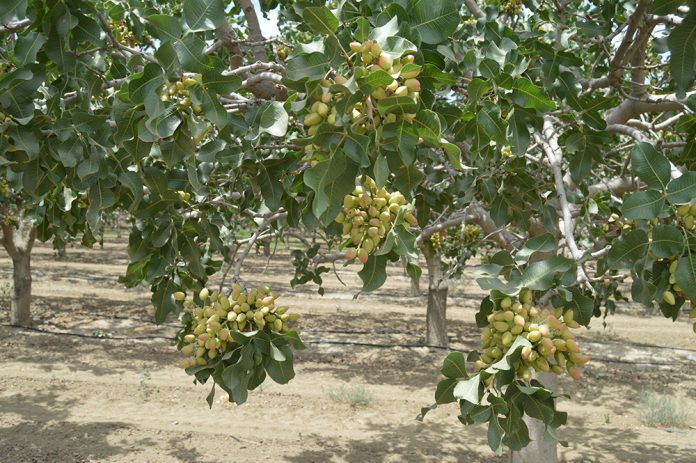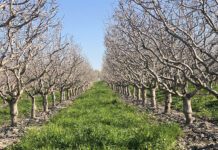
Record-breaking heat during bloom and early September, a second straight year of meager precipitation, a freak rain event in mid-September and a mild winter combined to affect pistachio yield and quality last year, according to a UCCE nut crops advisor.
While growers reported good production, it was not what they had hoped for in an “on year,” according to Mae Culumber, nut crops advisor for Fresno and Kings counties. And researchers have tried to delve into the reasons why.
Culumber said the two main issues that affected the 2022 pistachio production were high temperatures during bloom and early September and the rain event on September 18, which dropped 0.2 to 0.4 inches in some areas of the San Joaquin Valley.
The extreme heat followed by the freak rain event exacerbated quality issues for both Kerman, which was between the first and second shake, and in some cases Golden Hills, she said. “In the areas that it rained, it really affected quality, particularly for Kerman trees that ripen earlier. The nuts on trees waiting for a second shake were in an advanced stage of ripening, and the added moisture advanced decomposition of the hull and increased issues with fungal pathogens,” Culumber said.
“The hulls are already starting to fall away when the nuts are ripe,” she added, “and so that exposes the shell and advances decomposition on the hull and creates moist, warm conditions, which is bad for fungal pathogens like late blight Alternaria that leads to staining of the shells.” Staining, which was reported to be higher than normal in several production areas, but not in all, also can be caused by navel orangeworm and Gill’s mealybug insect damage, delayed harvest, intense heat during harvest and extended durations between harvest and processing, she said.
Some growers north of Fresno County escaped the rain, Culumber added, but were inundated with temperatures that rose to 114 degrees F in some areas over the Labor Day Weekend. “The heat alone likely also played a big factor,” she said. “Aspergillus is a pathogen that thrives in heat and stains shells yellow.”
Winter Chill
Reports of low accumulations of winter chill and high temperatures during bloom also could have played into the less-than-ideal yields, Culumber said.
“Any time you have a delay in leaf-out, that slows down the tree’s ability to photosynthesize and produce the carbohydrates that it puts into the new developing crop,” Culumber said. “So, you might get more aborted nuts if the tree doesn’t have the reserves to sustain that development. And any year that we get low chill, there can be problems with flowering and leaf-out.”
Low chill hours also can affect the ability of male and female varieties to sync, which can lead to reduced pollination, she said. And low winter chill hours typically lead to a later average bloom date, which, as it did last year, can expose pistachios to warmer temperatures in the spring, affecting flowering and pollination.
Another contributing factor to the lower-than-expected yields in 2022 may have been the size of the 2021 crop, which, for an off year, was high.
Mitigation
In general, there isn’t a lot a pistachio grower can do to minimize the affect of weather on crop, Culumber said. But there are considerations. For one, she said, going with an earlier maturing variety, like Golden Hills, has several advantages, including potentially sparing a crop from high temperatures during bloom.
“One of the reasons Golden Hills is a good option is because the later it gets in the season, the hotter it is going to be during bloom, and so it is beneficial to have those earlier blooming, earlier nut-setting varieties,” she said.
Also, in theory, the earlier a variety is harvested, the less problems it will have with navel orangeworm.
“Golden Hills is not without its problems,” Culumber said, “but because it has that earlier harvest, that has helped minimize problems with the navel orangeworm, because the longer the nuts are on the tree, the more lifecycles, the more opportunity the navel orangeworm has to ruin the crop.”
Another option that growers could consider is to leave male pollinators unpruned, something researchers have been looking at as of late.
“Something we are interested in in some of our tree-training trials where we are doing modified central-leader training versus a reduced pruning or no pruning treatment, is to see if that is increasing pollen set,” Culumber said.
“We don’t have data to show that is increasing nut set,” Culumber added. “That’s just a theory right now, but it might be an interesting thing for people to try, to maybe leave the male trees unpruned to possibly get more male flowers for pollination.”
Postharvest Steps
Good postharvest practices also can help growers minimize issues with weather.
“Postharvest is a good time to check on your irrigation system to make sure you are getting good distribution uniformity and do maintenance if you haven’t done a distribution uniformity test in a long time because the evenness of your watering really has an impact. You don’t want to be overirrigating some portions of the orchard and underirrigating other portions.
“It is also important to get some water on immediately after harvest to give the trees a little bit of relief,” she said. “We tend to think that is very critical in almonds, and it’s important in pistachio, too. We don’t tend to stress pistachio as much going up into harvest as we do the almonds but getting them a good drink after harvest is important.
“And do your sanitation for mummies,” she said. “There are always a good amount of nuts left on the trees, so if the weather allows, getting in for winter shaking and then shredding those mummies, making sure they are decomposing, should help reduce populations of navel orangeworm in the coming season.
“And make sure you are looking for fungal infections,” Culumber said. “That is the time to be removing some of those diseased branches from the orchard.”
Culumber said she didn’t know how much pistachio yields were down below grower expectations last year. But it is clear they were down to some degree. And while growers don’t have a lot of options for improving yield and quality during the season, she repeated there are steps growers can take to fend off the worst of weather’s effects.
“Some factors impacting yield and quality may be beyond control,” Culumber said, “while other issues can be mitigated by implemented best management practices in the postharvest season.”















